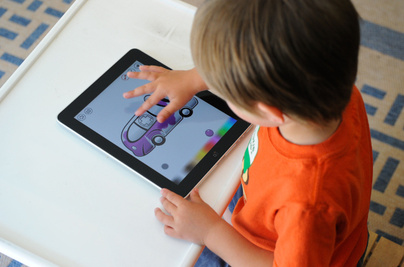The play of children between the ages of 2 and 5 becomes increasingly sophisticated and mature as they go from being toddlers to preschoolers. While they may initially be involved in solitary or parallel play at the age of 2 or 3, they engage in more cooperative and social play with their peers as they move to the ages of 4 and 5. It is also common for 4 and 5-year-olds to shift from having their parents or siblings as their primary playmates to more involvement with their peers. They begin to use their cognitive abilities to transform their world and become active learners, acquiring facts and knowledge and developing an understanding about relationships as well as memories about the people and places they encounter.
Children this age display increasing levels of sophistication in their play, moving away from the concrete and sensorimotor nature of infant play to one in which creativity and the capacity for make believe become more important. Playing “house,” “school,” “cops and robbers,” and “army” is likely to be far more important to children’s social and emotional growth and development at this age than playing on an iPad. Getting them to try new roles and learn to cooperate, plan, and take perspectives in play should be the be primary function of play at this age.
Srill, children between the ages of 2 and 5 tend to enjoy games and technologies that foster imaginative play and creativity and mastering basic academic skills. A healthy play diet for 2 to 5-year-olds involves a substantial amount of play that uses their cognitive abilities. These newly-acquired and very visible cognitive abilities sometimes encourage parents to provide their children with “lessons” to promote their learning. However, I caution parents to find a balance among lessons, educational games, and academic training that takes away from the primary importance of free and unstructured play for children this age.
Here are play diet recommendations for developmentally-healthy activities for children between ages 2 and 5 across the five types of play — social, active, creative, free and digital play.
Social Play
Games and play become increasingly interactive and social. This may range from playing a board game with a sibling to playing with dolls or trucks with friends. Social play develops from simply sitting together in the same space as a 2-year-old to a group of 5-year-olds playing “school” or “house” with each other or an older sibling.
Active Play
While 2-year-olds are still acquiring new motor skills, they are also beginning to enjoy running around playgrounds and ballfields. As they progress towards the age of 5 they can become more independent in this regard, climbing the stairs to a slide and being able to understand the rules of playing tag. They will also begin to enjoy some of the skills they may later use in sports, although their knowledge and understanding of the rules of the game will wait until they get to the next stage of development.
Creative Play
This is an opportunity for children to explore their interests and skills. It could involve developing artistic talents such as playing music, painting, or sculpting with clay. Creative play may also include construction, building, mechanical, or engineering play activities with Legos, blocks, wood, or other household materials.
Free Play
This is the most important part of play for children between the ages of 2 and 5. Simply using their imagination with whatever materials they have available is important for their cognitive growth and development. Free play allows them to explore all of their senses, learn more about interacting with others, and discover their likes and dislikes. It is an opportunity to get dirty, find out what breaks when you play with it roughly, and just be silly.
Digital Play
Digital play becomes relevant between the ages of 2 and 5, as children can benefit from appropriately-designed technologies and often have an understanding of how to operate them effectively. Digital play becomes a more prominent part of a preschooler’s life at home and school for most children in the United States, whether it be watching their favorite cartoon on television, enjoying a movie, or using a learning app. Many preschoolers also acquire reading skills by playing with educational apps.
Digital media can be an enormous asset for preschoolers who are identified as struggling learners. Children who have difficulty learning letters and numbers in preschool and may already avoid schoolwork tend to be far more interested in using fun and engaging apps that teach them the same content.
Digital play strategies for children between the ages of 2 and 5:
-
Joint media engagement. The involvement of an adult or caretaker with a preschooler who is using technology is the key for healthy, interactive digital-media use for preschoolers.
-
Educational games should be playful. The most important way that your preschooler learns is through play. Choose educational apps and games that are fun and engaging if you want preschoolers to use them.
-
Own the technology. Let your preschooler use your phone, tablet, or computer when you choose. It should not be simply another toy in the toy box.
Recommended games and apps:




